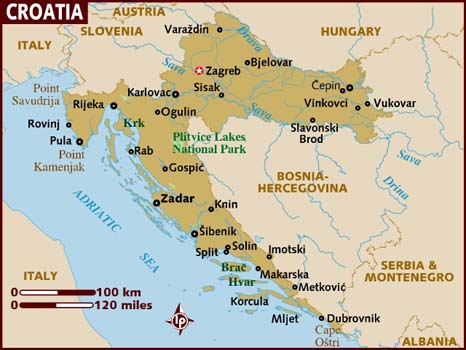| RV Rentals, Motorhome hire and Camper rent in Croatia |

Where to go in CroatiaCroatia’s capital Zagrebis a central European metropolis,with elegant nineteenth-century buildings. It’s also a good base for trips to the hills and charming villages of the rural Zagorje region to the north, and to the well-preserved Baroque town of Varaždin to the northeast. Stretching east from Zagreb, the plains of Slavonia form the richest agricultural parts of Croatia, with seemingly endless corn and sunflower fields with provincial towns such as Osijek and Vukovar the latter, almost totally destroyed during the 1991–95 war, is now getting reconstructed. You can go hiking on Mount Medvednica, just above Zagreb, or the Samoborsko gorje, just to the west of the capita., Also lying between Zagreb and the coast, and easily visited from either, are the Plitvice Lakes, an enchanting sequence of forest-fringed turquoise pools linked by miniature waterfalls. At the northern end, the peninsula of Istria contains many of the country’s most developed resorts, along with old Venetian towns like Poreč and Rovinj, and the port ofPula, home to some impressive Roman remains. The island-scattered Kvarner Gulf, immediately south of Istria,with cities well worth a visit as Rijeka and Opatija. The Kvarner islands of Cres, Lošinj, Krk and Rab, which has the best-preserved medieval town in the northern Adriatic are also much visited. Dalmatia is a dramatic, mountain-fringed stretch of coastline studded with islands. It’s an arid region where fishing villages and historic towns cling to a narrow coastal strip which is rich in figs, olives and subtropical vegetation. Zadar is the main city crammed with medieval churches. The Renaissance cathedral in Šibenik, is also a good stop en route to the waterfalls of the Krka National Park just inland, and the bare islands of the Kornati archipelago. Croatia’s second city is Split, with an ancient centre moulded around the palace of the Roman emperor, Diocletian. The closest islands to Split are Šolta and Brač, where you’ll find lively fishing villages and some excellent beaches, while nearby Hhvar and Korčula feature smallish towns brimming with Venetian architecture and numerous beaches. Further away the islands of Vis and Lastovo, which were closed to tourists until the late 1980s, remain particularly pristine. South of Split is the walled medieval city of Dubrovnik. Much of the damage inflicted on the town during the 1991–95 war has been repaired. One of the Adriatic’s most beautiful islands, the densely forested and relaxingly serene Mljet can be reached from Dubrovnik. Road conditions / restrictionsThe motorway system in Croatia has improved much in recent years. There are now motorways linking Zagreb to Pula, Rijeka, Zadar and Split along the coast and Varazdin in the interior. Further works have commenced to eventually allow a full coastal motorway all the way to Dubrovnik.The Croatian Auto Club (Hrvatski Auto Klub - HAK) has produced an app for smart phones that is very useful. The app details live traffic conditions, webcam images of important road points, petrol prices, information about nearest points of interest (airports, campsites, ATMs, hospitals, pharmacies, tourist boards) and more. Where to campCroatia has more then 250 campsites from minicamping to big tourist resorts. More than 2 million people visit Croatia each year on a camping holiday. You can find all campsites on www.camping.hr VisaHealthEmergency telephone numbersIf you need road assistance, the Croatian Auto Club Emergency Service will help you. The telephone number is 987.Best time to visit |
|||
 Croatia
Croatia 
